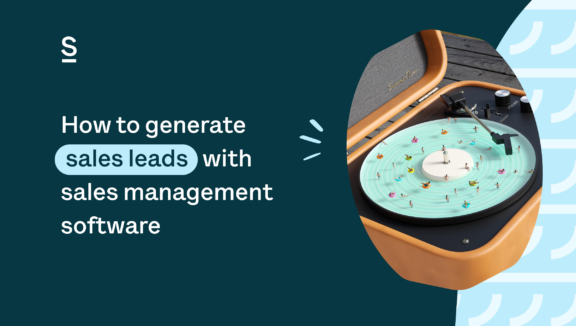How to generate sales leads with sales management software

The right software (CRM and beyond) can help you efficiently generate sales leads and keep track of business activities.
Generate sales leads is a key part of the selling process. After all, without leads, you’re at a loss for prospects, clients, and customers. From a high-level perspective, generate sales lead could essentially make or break your business — it may be just the thing that gives you business in the first place.
And sales lead generation doesn’t have to be tedious and time-consuming. Sales management software streamlines this process and makes it easy for you and your company to generate leads, move customers down the sales pipeline, negotiate successful deals, and keep track of everything you need to know along the way.
This article will dig into how to generate sales leads and best organize and control the sales process from start to finish using helpful sales tools such as sales management software.
A little bit about the sales process — and why sales management software is essential for success
Sales process 101
You’re probably already familiar with how the sales process works. If not, it goes a little something like this:
- Prospect. Start searching!
- Lead qualification. Are your prospects legit?
- Company research. How can you best present your product to qualified leads?
- Pitch. Tell qualified leads exactly why your product is right for them in a concise, curated, and personalized manner.
- Move through the process. Communicate, answer questions, make notes, form a relationship, and create a plan.
- Close deal. That’s right, close it!
- Continue relationships. Just because you closed one deal doesn’t mean it’s over. Stay in touch with your clients and nurture these relationships, so one deal turns into many deals.
While this chart provides a very basic overlook of the sales pipeline, the first few points may be the most important. If you don’t first find the right prospects, qualify them, and connect with them, you’ll never be able to pitch them or continue moving through the selling process.
And these first few steps are often easier said than done. When dealing with 10, 20, hundreds, or even thousands of possible leads, things can get messy fast. And this is where sales management software comes in.
Sales management software (a CRM) saves the day for sales lead generation (and more)
Sales management software comes in the way of a CRM (Customer Relationship Management). CRMs help salespeople contact prospects, track interaction, and prioritize tasks to ensure that relationships are formed, nurtured, and maintained. Timing is key when it comes to the sales process — if the timing is off, prospects are lost, and so are deals. CRMs can make sure all steps are done at the right time without missing a beat.
When referring back to the aforementioned summary of the sales process, sales management software can help in so many ways, from keeping track of leads to making sure they’re contacted at just the right moments. These systems note pitching, interaction, and responses and organize everything, so it’s easy to see the status of a deal or find information on a client relationship. CRMs keep track of data from start to finish, from finding prospects to post-deal interaction.
Sales management systems do the tedious work so you can focus on selling
Did you know that 92% of businesses claim that a CRM played an essential role in achieving their income goals? That’s right. It’s not just helping out here and there — a CRM can play a pivotal role in a company’s financial success.
When sales management systems do the busy work, salespeople can sell. And more time for selling? That means more closed deals, more money, and more ROI.
If you’re wondering how a mere software system can help meet income goals, consider the following ways sales management systems can help:
- Manage contacts and their information
- Perform organizational and administrative tasks
- Track deals
- Manage budget
- Manage inventory
- Create reports and provide tools for analysis
- Save money by reducing mistakes and errors
When a system is dealing with the above, salespeople have more time to communicate with clients and drive sales. And the very important last bullet point, about saving money by reducing mistakes and errors, brings us back to the statistic we started this section off with: that CRMs can help achieve income goals. Not only do they help salespeople focus on selling, but they actually help reduce mistakes, and all these things contribute toward increasing the bottom line.
How to build a sales management strategy
Although the easy way out would be to get a CRM and call it a day, that’s not to your advantage. Sales tools such as sales management software work best when used in conjunction with a strategy — and not just any strategy — a well-organized, curated plan that aligns with your company’s goals.
Customer relationships require a deep level of personalization, focus, and commitment, so building a strategy around that and supplementing it with sales or lead generation software is an optimal plan for sales success.
Key steps for building a sales management strategy
1. Define goals. Create a vision for your company, sales processes, and customer relationships.
2. Define your target customer and customer experience. It’s not enough to just dream up that perfect client. Once you detail out your target client, then explain the ideal process they’ll need to pass through when becoming a customer.
3. Figure out how your company can create that experience. Once you know what type of experience you want a customer to have, the next step is figuring out how your company can give them to them. Having a deep understanding of your own product, your target customer, and the general market (yes, even your competitors) can help you best serve your client.
4. Make your CRM work for you. You now know your customer, your process, and how you want to create it. This is where sales management software can support you — in lead generation, organization, tracking, and analyses — so you can focus on important parts of the sales process, like maintaining client relationships and closing deals.
Maximize your sales management software for lead generation
It’s not always enough to have a CRM and a solid sales management strategy. Even these organizational systems won’t give you back time spent on tedious data entry and administrative tasks. In fact, 72% of salespeople spend over 60 minutes per day on data entry. If it weren’t for those boring tasks, salespeople could spend an extra hour each day selling (or on customer relations, marketing strategies, or a million other things).
Sales management software such as Surfe can help generate sales leads and integrate seamlessly with your CRM. In fact, it’s essentially the middle man between systems like LinkedIn and your CRM. Not only does using Surfe mean that sourcing prospects on LinkedIn only takes about half the time, but the extension also doubles your efficiency by automatically inputting the information in your CRM so you don’t have to type it there. In fact, various case studies have shown that Surfe saves salespeople hundreds of hours of mindless data entry tasks per month, hours that they can dedicate to more important parts of the sales process.
The browser extension creates an easy, two-way sync of LinkedIn contact info, status, conversations, tasks, notes, activity, and ownership of the lead, easily visible to every member of your company.
Want to earn back more time in your day? Try giving Surfe a shot. Sign up for your free 14 day trial to learn more about the tool or book a demo to get started with one of our sales experts.
Effective sales management is the key to success (and ROI)
Effective sales management software leads to tangible results
Many people think that using sales management software, like a CRM, or even a tool such as Surfe can provide tangible results, such as improving sales.
And it can.
Using CRM software can increase sales by up to 29 percent, according to a study by Salesforce. Surfe saves you an hour a day. More time means more selling. More sales lead to a higher ROI.
These are tangible results, and we’re thrilled to have measurable, substantial data that shows us that, yes, sales management software works.
Intangible results are invaluable and lead to even more tangible results
It’s important to think about the intangible results of sales management software, which often come in the form of curating and maintaining those loyal, happy clients and customers.
When salespeople have time to curate the best client relationships possible, this has intangible effects that may later turn into more tangible ones. Happy clients are loyal clients. Loyal clients are repeat clients. Repeat clients not only return but refer you to what are usually qualified leads that likely fit your target customer profile. This is basically free marketing, and these new clients will hopefully turn into happy clients, and the system continues. These are clear examples of how customer retention and company reputation are largely driven by intangible results that later turn into tangible results like a higher ROI.
Don’t forget about the positive intangible effects that organizational systems can have across your company and your team. They help avoid mistakes, improve communication, and make your employees happier. This can also lead to more sales and better relationships among both employees and clients.
Sales management software generates sales leads and offers results
Using a CRM and other sales management software like Surfe can help generate sales leads and organize your data. These tools allow salespeople to focus on client relationships and free up time for them to actually sell, which increases the bottom line and ROI.
Have you enjoyed reading this article? We think you might also like the ones related to…
Also, if you have not done it yet, do not hesitate to take a look to our CRM-related pages:


